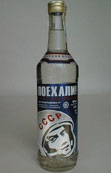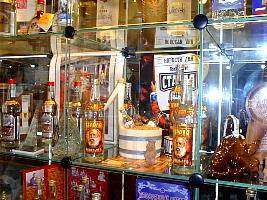| Hot offers | Hot line/Contact us |
General
Information
Accommodations
Entertainment
Dining
Shops
Services
Culture
Religious relics
Real Russia
Russian cuisine
Russian
vodka
Russian folk show
Russian clothes
Russian banya
Maps
About us
RUSSIAN
DRINKING TRADITIONS
 The new place became to the tsarТs liking and the entertaining place.
Thanks to that, the inexhaustible source of treasury enrichment was
found.So, since 1555 kabaks appeared in different Russian cities and
got into the traditional place to have a drink and a special particularity
of Russian urbanism. Only common people were allowed to drink in the
kabaks. People of upper classes should drink alcohol at home and the
people whose activity was the art should not drink alcohol at any
rate.Successful years of Peter the GreatТs government, whose love
towards the feasts and festivals was the talk of the country, accustomed
people to much alcohol.
The new place became to the tsarТs liking and the entertaining place.
Thanks to that, the inexhaustible source of treasury enrichment was
found.So, since 1555 kabaks appeared in different Russian cities and
got into the traditional place to have a drink and a special particularity
of Russian urbanism. Only common people were allowed to drink in the
kabaks. People of upper classes should drink alcohol at home and the
people whose activity was the art should not drink alcohol at any
rate.Successful years of Peter the GreatТs government, whose love
towards the feasts and festivals was the talk of the country, accustomed
people to much alcohol. But the tsar also brought in the strict order in alcohol drinking. It was the rule to work the whole week and allowed to have alcoholic drinks only on the holidays. Peter I loved alcohol so much that he could drink 36 glasses of wine during the day. Thanks to him, Russian Empire learned to drink vodka in a sweeping and joyful manner. Vodka was a must of a combat ration. Russian soldiers carried alcohol drinks to encourage themselves on the field of battle. The soldier got 2 cups of vodka (15-18%) every day.Simple workers were not deprived of their due share of vodka, too. One glass (charka) of low quality vodka was supposed to every builder, road worker or docker. In the middle of 18 century, in the time of Catherine II alcoholic beverage manufacturing became the privilege of the aristocracy. The last royal decree admitted the complete refuse of the state monopoly and control of private practices. During many centuries alcoholic beverage manufacturing differed by private, amateur character. The taste of Уbread wineФ was improved by numerous filtrations, freezing and rectifying. Every nobleman had his own brand of vodka and considered prestigious to have the A-Z assortment of vodka with different herbs: apple vodka, zest vodka an others. Drinking culture at that time was very high. The principal rule was to keep the mind sober and the view of things sensible. At the beginning of 19 century large PeterТs mug was changed by a German glass that was of less size. In kabaks small glasses (stopka Ц 100 g) came into fashion. Besides the stopka, people drank vodka in shkaliki (60 g) and charki (120 g). In 19 century the famous Russian chemist Mendeleev developed the basis of alcoholic beverage industry. He, first, determined the vague notion УvodkaФ with scientific characteristics. Vodka became the only name of principal Russian strong drink. Vodka is made from rye spirit, dissolved, by weight, in spring mild water until 40% alcohol. As during the experiments, Mendeleev found out that only 40% alcohol releases the maximum of heat and differs by the homogeneity. In 1894 MendeleevТs vodka was patented as the principal Russian alcoholic beverage, called УMoscow specialФ vodka. In conclusion, it is necessary to say that only vodka from Russia is the true vodka.
|
||||||
|
Our offers
|
|
|


 в
”гличе ћузей "Ѕиблиотека –усской водки".
в
”гличе ћузей "Ѕиблиотека –усской водки". 